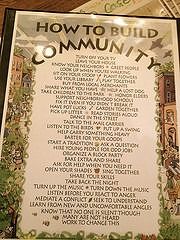This blog, Soulati-‘TUDE!, has the most amazing community, evah. Not lying; it’s vibrant, insightful, buoyant, supportive, accustomed to a good blog-jack, and full of ‘raderie. I love this community, and it wasn’t built overnight.
I’ve been “accused?” of being an excellent community builder; I cannot lie, I had no idea what that meant when someone shared that with me the first time. So I started to pay attention, and here are my tips on how to make your blog community blossom:
20 Tips to Build Blog Community
1. Engage with a commenter! So often when I hit a new blog and leave a comment, it’s crickets and I never go back.
2. Genuinely thank people for taking their time to come by and leave a thought. How many blogs are there now? A couple million? Good grief.
3. Be exceptionally welcoming (not drippy) to newcomers. You know who they are! It’s so cool when someone new stops in; thank them.
4. People’s time is so valuable; you have to respect those who stop in…until you get to know them, and then you can become more personable.
5. Mix up your topics. I did a test that Ralph Dopping was aware of…I wrote a post that was purely about public relations and he was the only one who commented. We deduced the post was not general enough and didn’t appeal to a wide audience. A general topic promotes more engagement; people feel more comfortable participating because the topic isn’t over someone’s head.
6. Do what I just did…take more time to go to someone’s blog and grab their latest blog post and insert it as a hyperlink in your post. When you do that, I’m getting a pingback, and I know automatically I’m coming over to say thank you.
7. Don’t just put a Twitter ID in your blog post when you mention someone because they are totally unaware they’re being called out.
8. Send a note on Twitter to the folks you really want to read your post; ask them/invite them to your blog. Kaarina Dillabough is perfect at this practice when she guest post; she’ll send me a note and I try to get there as often as I can to support her. She also informs me when I’m tagged in an article.
9. In comments, ask another question like Shakirah Dawud does. She’ll comment on your comment and then pose a question back to bring you back. Smart commenting.
10. Join Triberr. Can’t say enough about Triberr. You may think you don’t need it, but every blogger needs Triberr. I’ve written about this too many times to go on a Triberr tirade here; just trust me on this one.
11. Your comportment says so much about the community you’re trying to build…are you personable, laughing, flirtatious, serious, professional, funny, witty, open-minded, welcoming, consistent, paying attention? (Yes, blog communities demand all of that and more.)
12. Do you comment and return that favor on others’ blogs? I believe that commenting IS quid pro quo…you comment at my house, so I better show up at yours. What do you know about that? I’ve done some experimenting and have deduced it’s true. Commenting on others’ blogs definitely leads to community building.
13. I have often wanted a roll-call menu so I can tick off my name to say I visited; sometimes I don’t want to leave a comment, but I want the blog owner to know I stopped in. So, when you stop in and don’t leave a comment, think of something anyway and do let the blogger know you’ve come over…it’s like a courtesy. Commenting is not ding-dong-ditch!
14. Make a point of remembering peoples’ writings and recall that in comments. I cannot stress this enough. When you engage in comments and recall a post about someone recently wrote, then that visitor is impressed because you’ve made a point to make them feel special.
15. Ask for help, opinions, insight and expertise. No blogger knows it all; your community is a resource for you. When you ask for that knowledge, then you can build on it in a new post.
16. Reward your community with lists. Wait! Don’t yell at me…apparently, people hate lists that are link bait. I get that, but I don’t adhere to that practice. I do do lists and I do them infrequently; yet, when you see one here, it’s the real deal, written from the heart.
17. Help a newbie! When you see someone in your community struggling to get readers, commenters or topics, take them under your wing and try to help. Ask them to write a guest post for you, single them out in comments, use commenting systems that enable you to tag someone so they stop in…there are many ways to keep a community growing, and these are mine.
18. Add Comment-Luv or Lifefyre or another commenting system that allows commenters blog posts to be visible when leaving a comment. It’s a courtesy for visitors, and I love it because I can see what others are writing and jump there with one click.
19. Blog! You have to blog consistently to build community; no kidding. If you post once per week or less, or your blog has fallen off for more than a three-week hiatus, you’ll find your community disappearing or never growing. The consistency of posting is the secret sauce.
20. I’m done…no more tips! What’s your 20?







